Swine Grist
Dear Friends,
With crops pretty much planted now across the country many provinces, including Ontario, are looking for rain. We pray that frequent and gentle rains will come soon, allowing these new, emerging crops to get off to a great start and to help put out the forest fires that are burning in Alberta, the Maritimes, and now Quebec.
In reviewing recently released data from Iowa state, the financial strain that producers are experiencing has been confirmed. According to the data, market hog margins are at 20 year lows. It has been heartening for livestock producers to witness the recent decreases in feed commodity prices and some strengthening of the pork price but margins remain extremely tight. It is at times like these where good data and information on individual production facilities becomes extremely valuable. Utilizing technology as described within this edition of the Swine Grist is something that more and more producers are embracing and thankfully, there may even be government funds available to help with the purchase of this technology. Improvements in feed efficiency pay big dividends to operational profitability. Measuring and monitoring growth and feed efficiency on an on-going basis allows for greater “on farm business intelligence” for better decision making surrounding management and feeding practices as well as rations. With the incorporation of BioForce and BioSure Nursery Feeds, basemixes and premixes and with the formulation and nutrition consulting of FNL’s Nutritionists; Samuel Waititu and Saymore Ndou; stories of excellent growth and performance with significantly reduced feed usage abound. It is exciting to hear of the improvements in efficiency that FNL customers are achieving, improving their profitability as well as their sustainability!
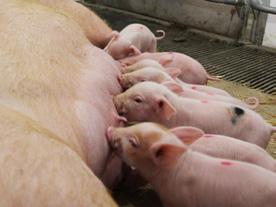
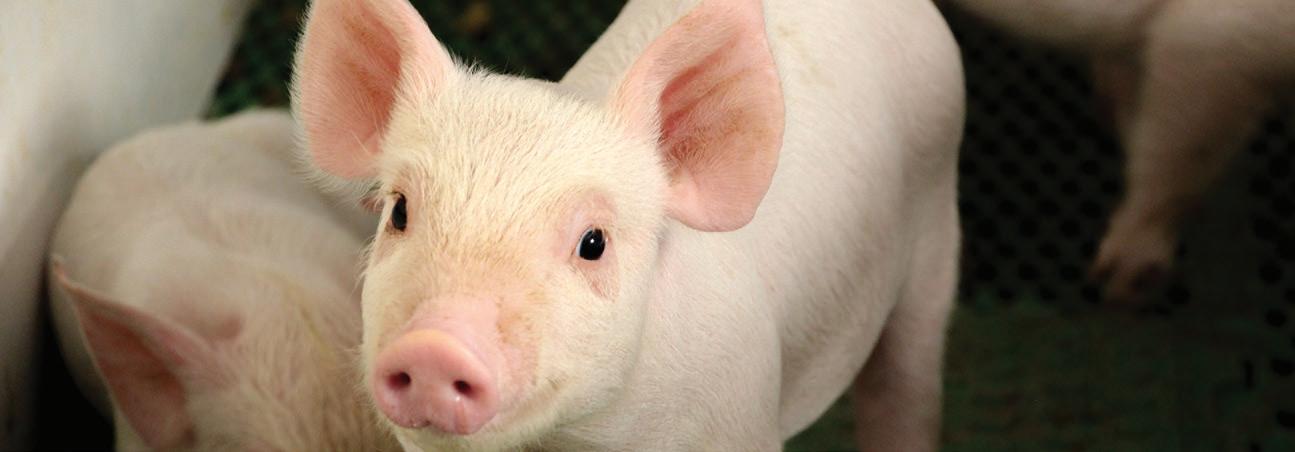
Sincerely,
Ian Ross, President & CEO

NEW & UPDATED EARLY NURSERY FEEDING PROGRAMS DESIGNED TO MEET PRODUCER GOALS
by: KEVIN DOLAN Nursery Feed Specialist, AB Neo(Primary Diets)As the Canadian swine industry continues to drive towards lower production costs, higher efficiencies, updated housing and later weaning, feeding programs need to continue to adapt as well. Certainly, over the last decade we have witnessed more pigs per litter, later weaning ages, and higher average weaning weights, with bigger weight ranges within those weaning weights. Embracing the realities of this ever changing swine market, the nutrition team at Grand Valley Fortifiers and Fortified Nutrition Limited, in collaboration with the nutritionists at AB Neo in the UK and Spain, have updated and simplified the recommended nursery feeding program from the GVF group of companies. This update includes the launch two new products, BioForce Initiate and BioForce Propel. Recognizing that not all nursery operators have the same nursery performance goals, we are pleased to launch three recommended feeding regimes for conventional producers to consider embracing in their nursery operations.
With the launch of the new BioForce Initiate and BioForce Propel, we have taken the opportunity to run several side by side trials with these products both in Ontario and in Manitoba. The following trial summary is indicative of the comparative results that we are achieving with the two recommended pelleted feeding programs (BioForce and BioSure) indicated in the table above.
Margin over feed = (Weight gain of pig *$3) – Feed cost. All feeds were medicated with Chlor/Tiamulin

These early results indicate that both the BioSure and the BioForce pelleted nursery feeds are performing exactly the way they were designed to perform in the nursery. We are pleased to offer these two recommended early nursery feed programs to producers, allowing them to select which program best suits their nursery feed cost and performance goals. We are also excited to witness the number of producers who are installing internet enabled in pen scales that allow for the on-going real time tracking of nursery pig growth (please see the related article in this edition of the Grist). We are also hopeful that in the near future, both Fortified Nutrition and Grand Valley Fortifiers will promote a device that hangs over the nursery feeder that is also internet enabled and tracks feed conversion on an on-going, real time basis. Once these devices are deployed along side of the in-pen scales, producers will have the same information provided in the trial data above, on an on-going basis for their own nursery operation, allowing them to monitor the results and truly understand their cost per kg of gain and margin over feed.
THE DUBLIN DECLARATION OF SCIENTISTS ON THE SOCIETAL ROLE OF LIVESTOCK
by: IAN ROSS President & CEOIf producers have been carefully watching social media (since most of main stream media has ignored this story) over the last few months, they may have been able to follow the numerous sizable protests by farmers that have taken place in Belgium and the Netherlands surrounding the Dutch government’s climate change focused plans to reduce nitrogen emissions through various means including the buyout and shuttering of 3000 Dutch Farms. With approximately 31,000 livestock farms in the
Netherlands, this plan represents a 10% reduction in farms. It has been heartening to witness some positive impact coming from these protests and the bringing of these issues to the public view as the new (2019) BBB party (Famer – Citizen Movement) recently won 17 seats in the Dutch Senate.
Within the context of a seemingly continuous flow of negative media surrounding livestock production and its alleged negative impact on the environment, it has also been heartening to witness the publishing of the Dublin Declaration in mid-October of 2022. At time of print over 1000 scientists from around the world have signed onto the Declaration, publicly confirming their commitment “to provide reliable evidence of their (livestock’s) nutrition and health benefits, environmental sustainability, socio-cultural and economic values, as well as for solutions to the many improvements that are needed”. At the GVF group of companies, we applaud the scientists who are willing to publicly ascribe to the Declaration, and willing to “research diligently, honestly and successfully in various disciplines in order to achieve a balanced view of the future of animal agriculture.” We believe that this is so very important to the future of livestock farming, food production, and more importantly, digestible protein security for the growing world population.
Purpose of this Declaration
Livestock systems must progress on the basis of the highest scientific standards. They are too precious to society to become the victim of simplification, reductionism or zealotry. These systems must continue to be embedded in and have broad approval of society. For that, scientists are asked to provide reliable evidence of their nutrition and health benefits, environmental sustainability, socio-cultural and economic values, as well as for solutions for the many improvements that are needed. This declaration aims to give voice to the many scientists around the world who research diligently, honestly and successfully in the various disciplines in order to achieve a balanced view of the future of animal agriculture.
Challenges for Livestock

Today’s food systems face an unprecedented double challenge. There is a call to increase the availability of livestock-derived foods (meat, dairy, eggs) to help satisfy the unmet nutritional needs of an estimated three billion people, for whom nutrient deficiencies contribute to stunting, wasting, anaemia, and other forms of malnutrition. At the same time, some methods and scale of animal production systems present challenges with regards to biodiversity, climate change and nutrient flows, as well as animal health and welfare within a broad One Health approach. With strong population growth concentrated largely among socioeconomically vulnerable and urban populations in the world, and where much of the populace depends on livestock for livelihoods, supply and sustainability challenges grow exponentially and advancing evidence-based solutions becomes ever more urgent.
Livestock and Human Health
Livestock-derived foods provide a variety of essential nutrients and other health-promoting compounds, many of which are lacking in diets globally, even among those populations with higher incomes. Well-resourced individuals may be able to achieve adequate diets while heavily restricting meat, dairy and eggs. However, this approach should not be recommended for general populations, particularly not those with elevated needs, such as young children and adolescents, pregnant and lactating women, women of reproductive age, older adults, and the chronically ill. The highest standards of bio-evolutionary, anthropological, physiological, and epidemiological evidence underscore that the regular consumption of meat, dairy and eggs, as part of a well-balanced diet is advantageous for human beings.
Livestock and the Environment
Farmed and herded animals are irreplaceable for maintaining a circular flow of materials in agriculture, by recycling in various ways the large amounts of inedible biomass that are generated as by-products during the production of foods for the human diet. Livestock are optimally positioned to convert these materials back into the natural cycle and simultaneously produce high-quality food. Ruminants in particular are also capable of valorising marginal lands that are not suitable for direct human food production. Furthermore, well-managed livestock systems applying agro-ecological principles can generate many other benefits, including carbon sequestration, improved soil health, biodiversity, watershed protection and the provision of important ecosystem services. While the livestock sector faces several important challenges regarding natural resources utilization and climate change that require action, one-size-fitsall agendas, such as drastic reductions of livestock numbers, could actually incur environmental problems on a large scale.
Livestock and Socio-Economics
For millennia, livestock farming has provided humankind with food, clothing, power, manure, employment and income as well as assets, collateral, insurance and social status. Livestock-derived foods are the most readily available source of high quality proteins and several essential nutrients for the global consumer. Livestock ownership is also the most frequent form of private ownership of assets in the world and forms the basis of rural community financial capital. In some communities, livestock is one of the few assets that women can own, and is an entry point towards gender equality. Advances in animal sciences and related technologies are currently improving livestock performance along all above mentioned dimensions of health, environment and socio-economics faster than at any time in history.
Outlook for Livestock*
Human civilization has been built on livestock from initiating the bronze-age more than 5000 years ago towards being the bedrock of food security for modern societies today. Livestock is the millennial-long-proven method to create healthy nutrition and secure livelihoods, a wisdom deeply embedded in cultural values everywhere. Sustainable livestock will also provide solutions for the additional challenge of today, to stay within the safe operating zone of planet Earth’s boundaries, the only Earth we have.
For scientific evidence, please refer to presentation recordings from the 19/20 October 2022 International Summit on the Societal Role of Meat. Evidence will also be published in the March 2023 Special Issue of Animal Frontiers.
* The wording of this paragraph is from the Solution Cluster on Sustainable Livestock at the UN Food System Summit 2021.
DATA TRACKING ON FARM - IT ONLY MAKES SENSE
by: by: VICTORIA SEIP EISSES Livestock Business Intelligence Manager, Grand Valley Fortifiers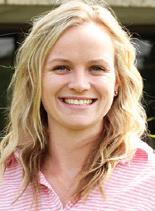
Over the last few years, we as a team have tried to bring new and easy ways to track data on-farm to our customers across the country. Data is important for agricultural business operations because it allows for accurate decisions to be made in real-time, not waiting until the end of a group of pigs. In tough times like these, accuracy is important because we need to make sure we are
farming smart by fine tuning areas of production in order to save cost and increase efficiency. Optimizing feed conversion, growth and efficiency is critical in order to find cost savings in day-to-day production.
Several dozen of our customers in Western Canada have readily utilized the PigScale which is an in-pen scale taking voluntary pig weights to view both daily, weekly and batch trends in order to make management decisions such as changing feeding regimes, feed time changes, vaccination times etc. In the east, we are also in the preliminary stage of testing out a Gestal nursery feeder to go along with these in pen scales in order to capture real time feed data as well in order to really have full oversight of either nursery or finishing production by measuring feed per pig, feed conversion and cost.
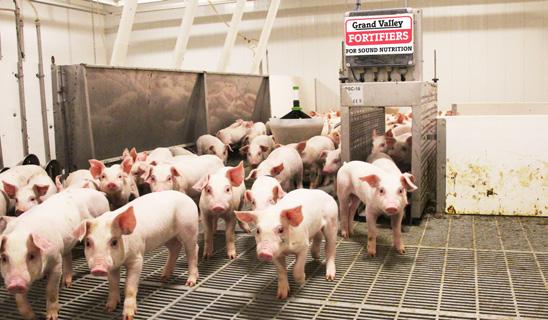
Recently, the Alberta Government has released The Sustainable Canadian Agricultural Partnership Farm Technology Program which is funding innovative technology that minimizes agricultural waste, optimizes farm efficiency and results in the digitalization of an operation and sensors for the purpose of data collection. In 2023-2024 the farm technology stream has a maximum of $48,000 available for projects to cover 50% of expenses related to the activities stated above. Funding is not guaranteed so it is important to make sure any applications being submitted are thorough.
Examples of technology that can be submitted to this funding include; digital sensors, data collection, connectivity, automated data analysis and efficiency improvement. More information for eligibility can be found at www.alberta.ca/farm-technology-program.aspx. We would encourage you to look into more detail on this opportunity to see how it may better your hog operation and help cover implementation cost“On-Farm Business Intelligience” tools and software.
TIGHTENING OUR BELTS: HOW TO GET BACK TO THE BASICS OF SWINE PRODUCTION AND SAVE MONEY DOING IT.
DREW WOODS Manager of Monogastric Nutrition, Grand Valley FortifiersWe all know the saying that “you can’t manage what you don’t measure”. This is a statement that is both simple and extremely valid. When tough times come and we want to make changes we need the best information possible to guide those decisions. If we don’t keep proper records or know how to harvest the knowledge contained in them we are making changes without full insight. Working through sow records or closeouts is an excellent way to spot trends, eliminate inefficiencies and help eliminate items that are not pulling their weight in the barn. If you are not sure how to do proper data mining and evaluation

that’s ok, there are experts at your benchmarking service, or elsewhere in the industry who are more than happy to assist. This leads me directly into my next item.
JOIN US IN WELCOMING OUR NEW SPECIALIST TO OUR TEAM!
Grand Valley would like to introduce Drew Woods as our new Manager of Monogastric Nutrition.

Involve all your stakeholders
We tend to want to try and fix problems ourselves but with complex businesses like swine operations that is not always the best approach. Taking the team approach will always garner better outcomes. Call a meeting with your vet, your genetics supplier, your feed rep and anyone else who can help influence your bottom line. Everyone mentioned above is a source of tips, tricks, feedback and information to help you re-align your production and make sure you are doing what is best for your business and your animals during this market downturn. Asking for help can be hard but the result is always worth it.
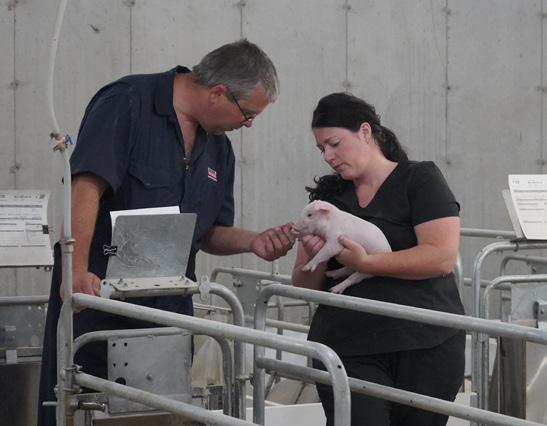
Be a tortoise and not a hare
Slow and steady wins the race when it comes to working through difficult markets. Snap decisions and operating out of fear only lead to poor outcomes. Take your time and ensure you are comfortable with the decisions you are making and that benefit your business not just in the immediate but in the long term. Remember, tough times don’t last, tough people do. You want to make sure you do not make a rash change that may save money in the short term but will impede your business in the medium and long term future. This could include things like letting your parity structure get skewed, reducing the cost and quality of feed to the point you impair growth and reproduction while increasing feed conversion or by cutting back on herd health expenses. While all of these sound tempting in the short term they have knock on effects that will slow any return to normal profitability in the future.
An ounce of prevention is worth a pound of cure
Moving along with the health theme, don’t ignore preventative measures in the barn. Whether that be routine vaccinations, keeping up on barn maintenance or maintaining your presence in the barn managing the animals. Small individual efforts add up to a large sum at the end of the day. Trying to prevent issues before they become large is key right now. Walk the pens and pull sick or poor doing pigs immediately and deal with them accordingly, losing a market hog to a fixable problem is always unfortunate and preventable. Don’t fall into half dosing vaccines or even skipping them, there are always nasty bugs just waiting for an opportunity to show up and wreak havoc. Finally, don’t let the animal environment fall into disrepair. It is hard to warrant investing time, and money into the barn but the maintenance bill will always be cheaper than the inevitable repair bill that comes from ignoring the issue.
Drew was born and raised in New Liskeard, Ontario and was surrounded by agriculture all of his life leading to his choice to attend the University of Guelph for Animal Science. Drew obtained both is B.Sc. (Agriculture) and M.Sc. (Swine Nutrition) from the University of Guelph and studied under the late Dr. Kees de Lange. His Masters focused on liquid feeding of newly weaned pigs as well as the use of co-products in swine diets. His research found that even young pigs respond in a robust manner to a variety of ingredients in their diets that many previously thought to be unpalatable to the young pig. As well, he noted that liquid fed nursery pigs can be managed across different barn set ups with no impact on performance. Finally, he showed that the presence of lactose in a swine diet does not impact the activity level of lactase enzyme in the animal.
DREW WOODS Manager of Monogastric NutritionDrew entered the swine industry in 2007 and worked in roles ranging from technical sales to technology application specialist and growth modelling manager. These roles took him from the local Ontario market to interactions and training of colleagues around the globe. This wide ranging skillset and international network has come along with him to Grand Valley Fortifiers in the role of monogastric nutritionist. Drew’s responsibilities include the updating of our formulation practices, acquisition and deployment of new technologies such as swine models, and the technical support of our sales staff.
On a personal note, Drew lives with his wife Jennifer and their son Tyce in Eden Mills. In his spare time he enjoys going home to Northern Ontario and spending time with his family in the wilderness, hunting, fishing and camping.
Please help us welcome Drew and feel free to reach out to him in his new role.
Drew can be reached at: drewwoods@grandvalley.com
